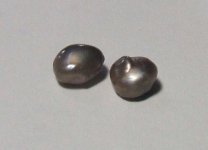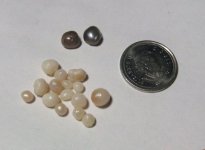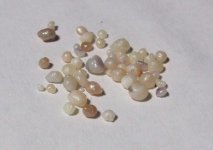We have had some discussion in the "grain of sand" threads, especially the relationship between predators and shellstock. It's my theory to take this one step further, by suggesting a commensal synbiotic relationship, apart from parasitism.
When observing my naturals, one often gets a hint of purple undertones.
For a very long time, I suspected purple sea urchins were implicated, but after cutting, peeling and breaking a few samples, I had hoped to find an urchin spine or grain of sand. I found neither.
Having seen a few markedly purple pearls, a pattern emerged.
In the top half of the the posted image, we see a collection of white naturals of similar tone. In the lower half, I flipped each of these off of their "flat spots" to reveal their purple over/undertones.
Okay, now this begs the question, why are these pearls colored purple on the flat spots?
We know in pearl culture, color is determined by the donor. We also know shellstock can be fouled by numerous species. My target species, the California mussel has no inherent tendency to produce purple tones in their shells, hence suggesting purple pearls are not homogenic in origin.
These purple flats, tend to be unlike the colors of most of my other naturals. (about 1-2% incidence) Purple colors can occur in several species, but they predominate in the venus clams (quahogs, manilas etc.) and in some pectens (rock scallops). Both of these groups occur in Canadian waters prolifically. Very often, they are found nestled between the tunicates and sponges on rocks, floats and shellstock.
Both of these bivalves have an intriguing transition, when they no longer swim and become sedentary. Venerupus sp, have more than treble the amount of byssal threads and as such, tend to be really sticky at metamorphosis. Rock scallops don't, but have a high external output of pallial fluid, which allows to concrete themselves rapidly to their holdfast.
Conchiolin has a high affinity for calcium carbonate. California mussels have thick conchiolin and as such are easily fouled. It's my assertion, the larvae of these scallops (and possibly clams) occasionally attach near to the mantle folds of mussels and become grafted to the tissues, hence replicating the color and extracrystalline structure of the donor.
In the attched image of the rock scallop shell, you'll see the purple is caused by the close proximity to the other valve. In the absence of conjunctions, this might explain the purple color at the flat spots and their xenogenic origin.
Cool eh?



